Changing Business Environment
VerifiedAdded on 2021/06/17
|6
|2265
|47
AI Summary
Contribute Materials
Your contribution can guide someone’s learning journey. Share your
documents today.
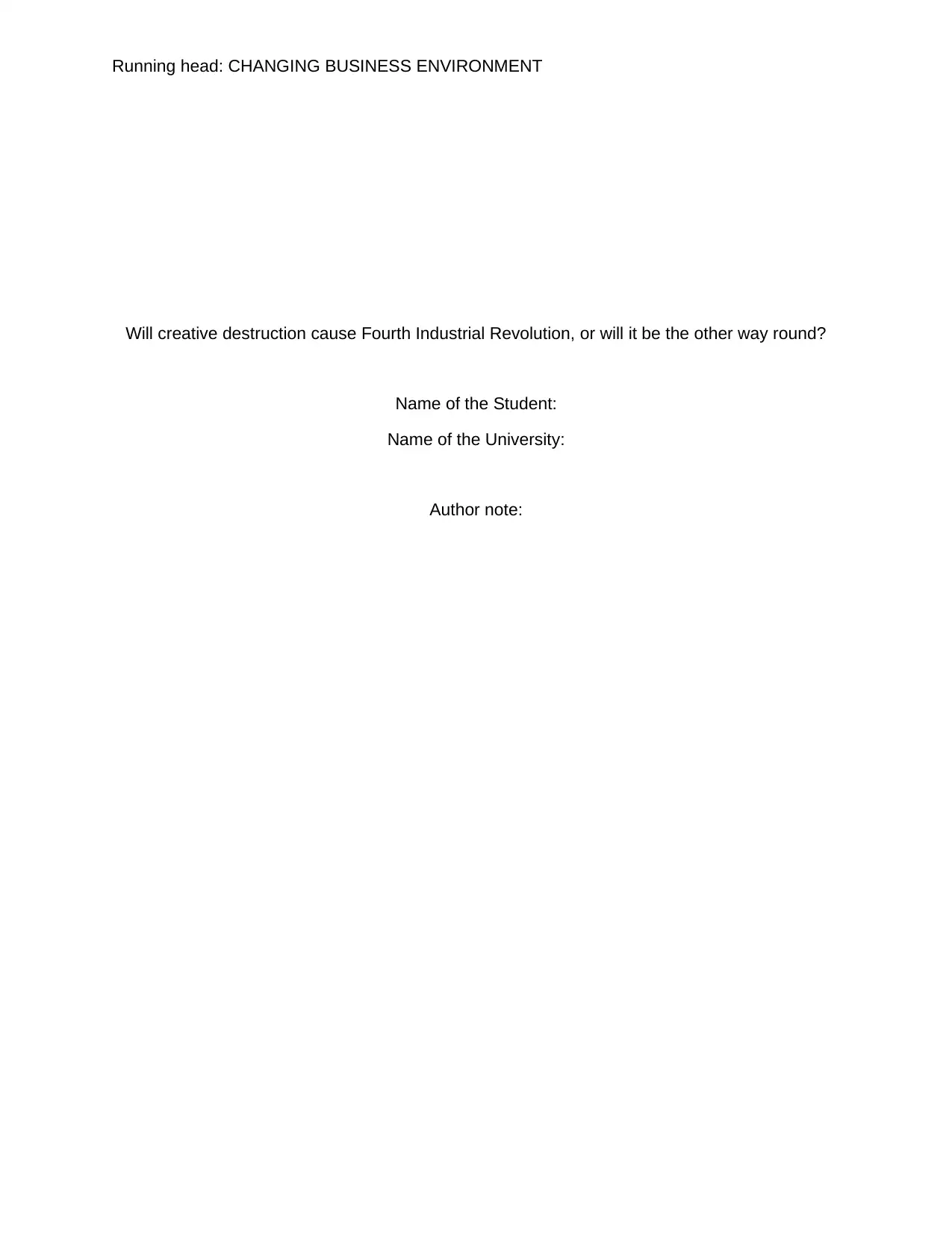
Running head: CHANGING BUSINESS ENVIRONMENT
Will creative destruction cause Fourth Industrial Revolution, or will it be the other way round?
Name of the Student:
Name of the University:
Author note:
Will creative destruction cause Fourth Industrial Revolution, or will it be the other way round?
Name of the Student:
Name of the University:
Author note:
Secure Best Marks with AI Grader
Need help grading? Try our AI Grader for instant feedback on your assignments.
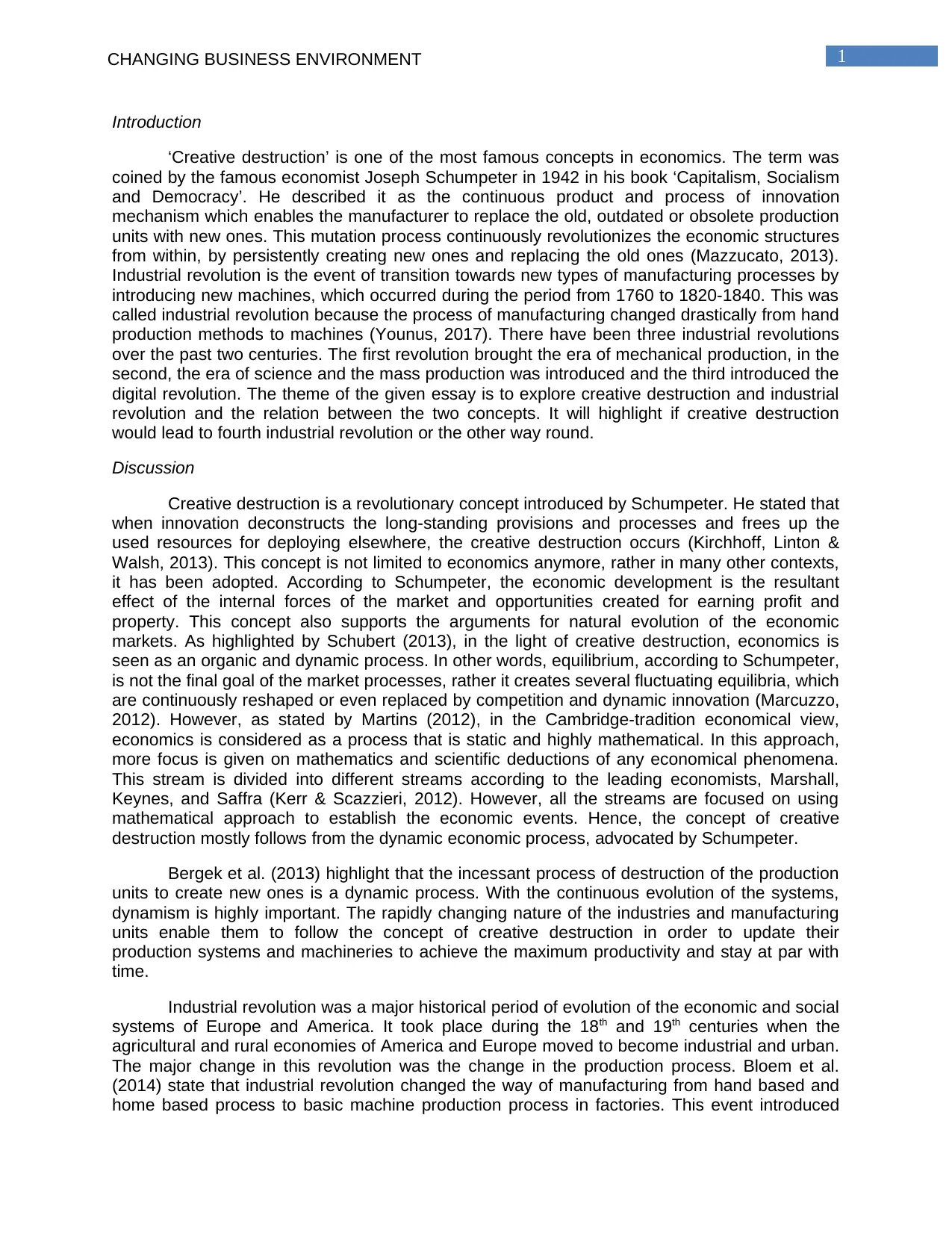
1CHANGING BUSINESS ENVIRONMENT
Introduction
‘Creative destruction’ is one of the most famous concepts in economics. The term was
coined by the famous economist Joseph Schumpeter in 1942 in his book ‘Capitalism, Socialism
and Democracy’. He described it as the continuous product and process of innovation
mechanism which enables the manufacturer to replace the old, outdated or obsolete production
units with new ones. This mutation process continuously revolutionizes the economic structures
from within, by persistently creating new ones and replacing the old ones (Mazzucato, 2013).
Industrial revolution is the event of transition towards new types of manufacturing processes by
introducing new machines, which occurred during the period from 1760 to 1820-1840. This was
called industrial revolution because the process of manufacturing changed drastically from hand
production methods to machines (Younus, 2017). There have been three industrial revolutions
over the past two centuries. The first revolution brought the era of mechanical production, in the
second, the era of science and the mass production was introduced and the third introduced the
digital revolution. The theme of the given essay is to explore creative destruction and industrial
revolution and the relation between the two concepts. It will highlight if creative destruction
would lead to fourth industrial revolution or the other way round.
Discussion
Creative destruction is a revolutionary concept introduced by Schumpeter. He stated that
when innovation deconstructs the long-standing provisions and processes and frees up the
used resources for deploying elsewhere, the creative destruction occurs (Kirchhoff, Linton &
Walsh, 2013). This concept is not limited to economics anymore, rather in many other contexts,
it has been adopted. According to Schumpeter, the economic development is the resultant
effect of the internal forces of the market and opportunities created for earning profit and
property. This concept also supports the arguments for natural evolution of the economic
markets. As highlighted by Schubert (2013), in the light of creative destruction, economics is
seen as an organic and dynamic process. In other words, equilibrium, according to Schumpeter,
is not the final goal of the market processes, rather it creates several fluctuating equilibria, which
are continuously reshaped or even replaced by competition and dynamic innovation (Marcuzzo,
2012). However, as stated by Martins (2012), in the Cambridge-tradition economical view,
economics is considered as a process that is static and highly mathematical. In this approach,
more focus is given on mathematics and scientific deductions of any economical phenomena.
This stream is divided into different streams according to the leading economists, Marshall,
Keynes, and Saffra (Kerr & Scazzieri, 2012). However, all the streams are focused on using
mathematical approach to establish the economic events. Hence, the concept of creative
destruction mostly follows from the dynamic economic process, advocated by Schumpeter.
Bergek et al. (2013) highlight that the incessant process of destruction of the production
units to create new ones is a dynamic process. With the continuous evolution of the systems,
dynamism is highly important. The rapidly changing nature of the industries and manufacturing
units enable them to follow the concept of creative destruction in order to update their
production systems and machineries to achieve the maximum productivity and stay at par with
time.
Industrial revolution was a major historical period of evolution of the economic and social
systems of Europe and America. It took place during the 18th and 19th centuries when the
agricultural and rural economies of America and Europe moved to become industrial and urban.
The major change in this revolution was the change in the production process. Bloem et al.
(2014) state that industrial revolution changed the way of manufacturing from hand based and
home based process to basic machine production process in factories. This event introduced
Introduction
‘Creative destruction’ is one of the most famous concepts in economics. The term was
coined by the famous economist Joseph Schumpeter in 1942 in his book ‘Capitalism, Socialism
and Democracy’. He described it as the continuous product and process of innovation
mechanism which enables the manufacturer to replace the old, outdated or obsolete production
units with new ones. This mutation process continuously revolutionizes the economic structures
from within, by persistently creating new ones and replacing the old ones (Mazzucato, 2013).
Industrial revolution is the event of transition towards new types of manufacturing processes by
introducing new machines, which occurred during the period from 1760 to 1820-1840. This was
called industrial revolution because the process of manufacturing changed drastically from hand
production methods to machines (Younus, 2017). There have been three industrial revolutions
over the past two centuries. The first revolution brought the era of mechanical production, in the
second, the era of science and the mass production was introduced and the third introduced the
digital revolution. The theme of the given essay is to explore creative destruction and industrial
revolution and the relation between the two concepts. It will highlight if creative destruction
would lead to fourth industrial revolution or the other way round.
Discussion
Creative destruction is a revolutionary concept introduced by Schumpeter. He stated that
when innovation deconstructs the long-standing provisions and processes and frees up the
used resources for deploying elsewhere, the creative destruction occurs (Kirchhoff, Linton &
Walsh, 2013). This concept is not limited to economics anymore, rather in many other contexts,
it has been adopted. According to Schumpeter, the economic development is the resultant
effect of the internal forces of the market and opportunities created for earning profit and
property. This concept also supports the arguments for natural evolution of the economic
markets. As highlighted by Schubert (2013), in the light of creative destruction, economics is
seen as an organic and dynamic process. In other words, equilibrium, according to Schumpeter,
is not the final goal of the market processes, rather it creates several fluctuating equilibria, which
are continuously reshaped or even replaced by competition and dynamic innovation (Marcuzzo,
2012). However, as stated by Martins (2012), in the Cambridge-tradition economical view,
economics is considered as a process that is static and highly mathematical. In this approach,
more focus is given on mathematics and scientific deductions of any economical phenomena.
This stream is divided into different streams according to the leading economists, Marshall,
Keynes, and Saffra (Kerr & Scazzieri, 2012). However, all the streams are focused on using
mathematical approach to establish the economic events. Hence, the concept of creative
destruction mostly follows from the dynamic economic process, advocated by Schumpeter.
Bergek et al. (2013) highlight that the incessant process of destruction of the production
units to create new ones is a dynamic process. With the continuous evolution of the systems,
dynamism is highly important. The rapidly changing nature of the industries and manufacturing
units enable them to follow the concept of creative destruction in order to update their
production systems and machineries to achieve the maximum productivity and stay at par with
time.
Industrial revolution was a major historical period of evolution of the economic and social
systems of Europe and America. It took place during the 18th and 19th centuries when the
agricultural and rural economies of America and Europe moved to become industrial and urban.
The major change in this revolution was the change in the production process. Bloem et al.
(2014) state that industrial revolution changed the way of manufacturing from hand based and
home based process to basic machine production process in factories. This event introduced
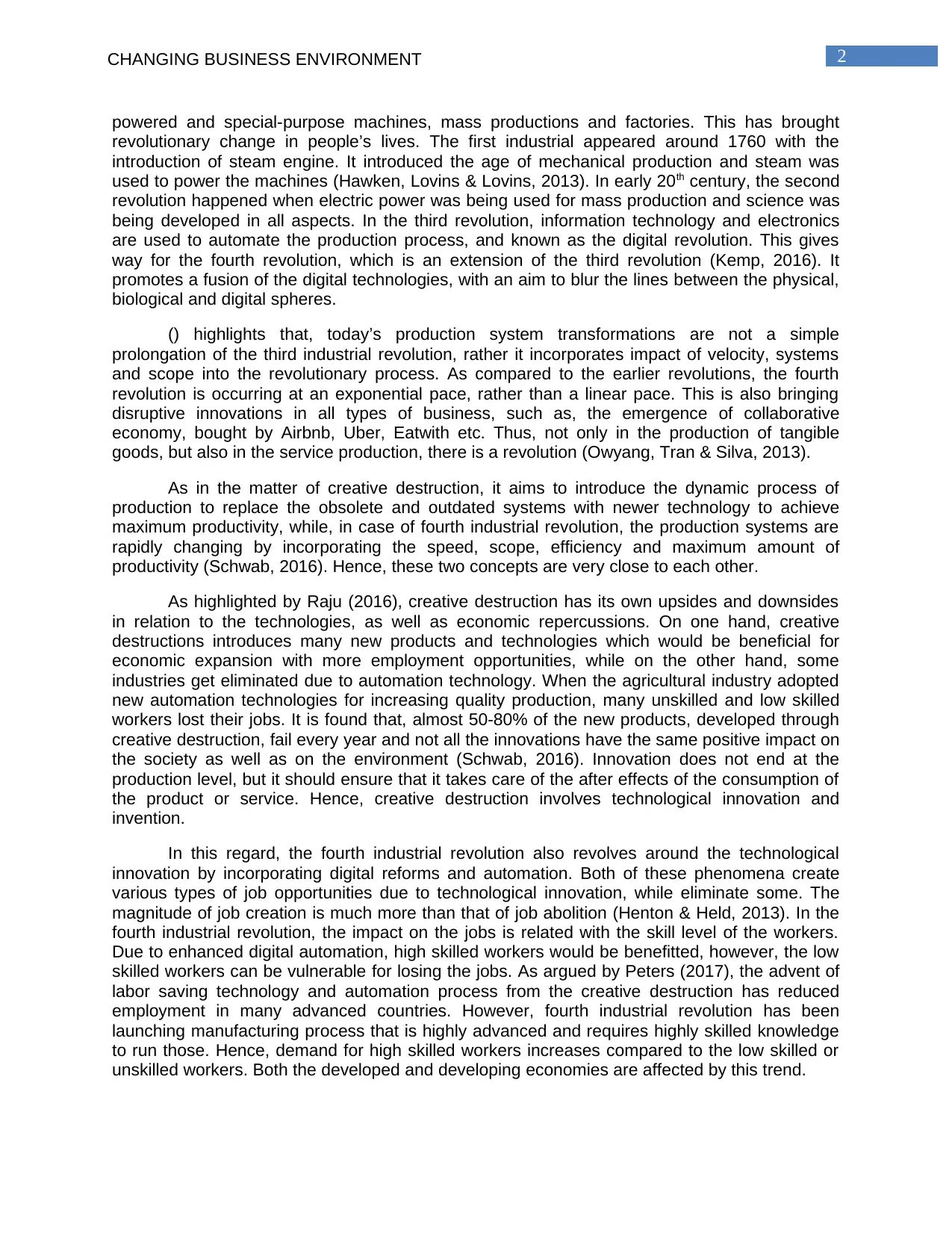
2CHANGING BUSINESS ENVIRONMENT
powered and special-purpose machines, mass productions and factories. This has brought
revolutionary change in people’s lives. The first industrial appeared around 1760 with the
introduction of steam engine. It introduced the age of mechanical production and steam was
used to power the machines (Hawken, Lovins & Lovins, 2013). In early 20th century, the second
revolution happened when electric power was being used for mass production and science was
being developed in all aspects. In the third revolution, information technology and electronics
are used to automate the production process, and known as the digital revolution. This gives
way for the fourth revolution, which is an extension of the third revolution (Kemp, 2016). It
promotes a fusion of the digital technologies, with an aim to blur the lines between the physical,
biological and digital spheres.
() highlights that, today’s production system transformations are not a simple
prolongation of the third industrial revolution, rather it incorporates impact of velocity, systems
and scope into the revolutionary process. As compared to the earlier revolutions, the fourth
revolution is occurring at an exponential pace, rather than a linear pace. This is also bringing
disruptive innovations in all types of business, such as, the emergence of collaborative
economy, bought by Airbnb, Uber, Eatwith etc. Thus, not only in the production of tangible
goods, but also in the service production, there is a revolution (Owyang, Tran & Silva, 2013).
As in the matter of creative destruction, it aims to introduce the dynamic process of
production to replace the obsolete and outdated systems with newer technology to achieve
maximum productivity, while, in case of fourth industrial revolution, the production systems are
rapidly changing by incorporating the speed, scope, efficiency and maximum amount of
productivity (Schwab, 2016). Hence, these two concepts are very close to each other.
As highlighted by Raju (2016), creative destruction has its own upsides and downsides
in relation to the technologies, as well as economic repercussions. On one hand, creative
destructions introduces many new products and technologies which would be beneficial for
economic expansion with more employment opportunities, while on the other hand, some
industries get eliminated due to automation technology. When the agricultural industry adopted
new automation technologies for increasing quality production, many unskilled and low skilled
workers lost their jobs. It is found that, almost 50-80% of the new products, developed through
creative destruction, fail every year and not all the innovations have the same positive impact on
the society as well as on the environment (Schwab, 2016). Innovation does not end at the
production level, but it should ensure that it takes care of the after effects of the consumption of
the product or service. Hence, creative destruction involves technological innovation and
invention.
In this regard, the fourth industrial revolution also revolves around the technological
innovation by incorporating digital reforms and automation. Both of these phenomena create
various types of job opportunities due to technological innovation, while eliminate some. The
magnitude of job creation is much more than that of job abolition (Henton & Held, 2013). In the
fourth industrial revolution, the impact on the jobs is related with the skill level of the workers.
Due to enhanced digital automation, high skilled workers would be benefitted, however, the low
skilled workers can be vulnerable for losing the jobs. As argued by Peters (2017), the advent of
labor saving technology and automation process from the creative destruction has reduced
employment in many advanced countries. However, fourth industrial revolution has been
launching manufacturing process that is highly advanced and requires highly skilled knowledge
to run those. Hence, demand for high skilled workers increases compared to the low skilled or
unskilled workers. Both the developed and developing economies are affected by this trend.
powered and special-purpose machines, mass productions and factories. This has brought
revolutionary change in people’s lives. The first industrial appeared around 1760 with the
introduction of steam engine. It introduced the age of mechanical production and steam was
used to power the machines (Hawken, Lovins & Lovins, 2013). In early 20th century, the second
revolution happened when electric power was being used for mass production and science was
being developed in all aspects. In the third revolution, information technology and electronics
are used to automate the production process, and known as the digital revolution. This gives
way for the fourth revolution, which is an extension of the third revolution (Kemp, 2016). It
promotes a fusion of the digital technologies, with an aim to blur the lines between the physical,
biological and digital spheres.
() highlights that, today’s production system transformations are not a simple
prolongation of the third industrial revolution, rather it incorporates impact of velocity, systems
and scope into the revolutionary process. As compared to the earlier revolutions, the fourth
revolution is occurring at an exponential pace, rather than a linear pace. This is also bringing
disruptive innovations in all types of business, such as, the emergence of collaborative
economy, bought by Airbnb, Uber, Eatwith etc. Thus, not only in the production of tangible
goods, but also in the service production, there is a revolution (Owyang, Tran & Silva, 2013).
As in the matter of creative destruction, it aims to introduce the dynamic process of
production to replace the obsolete and outdated systems with newer technology to achieve
maximum productivity, while, in case of fourth industrial revolution, the production systems are
rapidly changing by incorporating the speed, scope, efficiency and maximum amount of
productivity (Schwab, 2016). Hence, these two concepts are very close to each other.
As highlighted by Raju (2016), creative destruction has its own upsides and downsides
in relation to the technologies, as well as economic repercussions. On one hand, creative
destructions introduces many new products and technologies which would be beneficial for
economic expansion with more employment opportunities, while on the other hand, some
industries get eliminated due to automation technology. When the agricultural industry adopted
new automation technologies for increasing quality production, many unskilled and low skilled
workers lost their jobs. It is found that, almost 50-80% of the new products, developed through
creative destruction, fail every year and not all the innovations have the same positive impact on
the society as well as on the environment (Schwab, 2016). Innovation does not end at the
production level, but it should ensure that it takes care of the after effects of the consumption of
the product or service. Hence, creative destruction involves technological innovation and
invention.
In this regard, the fourth industrial revolution also revolves around the technological
innovation by incorporating digital reforms and automation. Both of these phenomena create
various types of job opportunities due to technological innovation, while eliminate some. The
magnitude of job creation is much more than that of job abolition (Henton & Held, 2013). In the
fourth industrial revolution, the impact on the jobs is related with the skill level of the workers.
Due to enhanced digital automation, high skilled workers would be benefitted, however, the low
skilled workers can be vulnerable for losing the jobs. As argued by Peters (2017), the advent of
labor saving technology and automation process from the creative destruction has reduced
employment in many advanced countries. However, fourth industrial revolution has been
launching manufacturing process that is highly advanced and requires highly skilled knowledge
to run those. Hence, demand for high skilled workers increases compared to the low skilled or
unskilled workers. Both the developed and developing economies are affected by this trend.
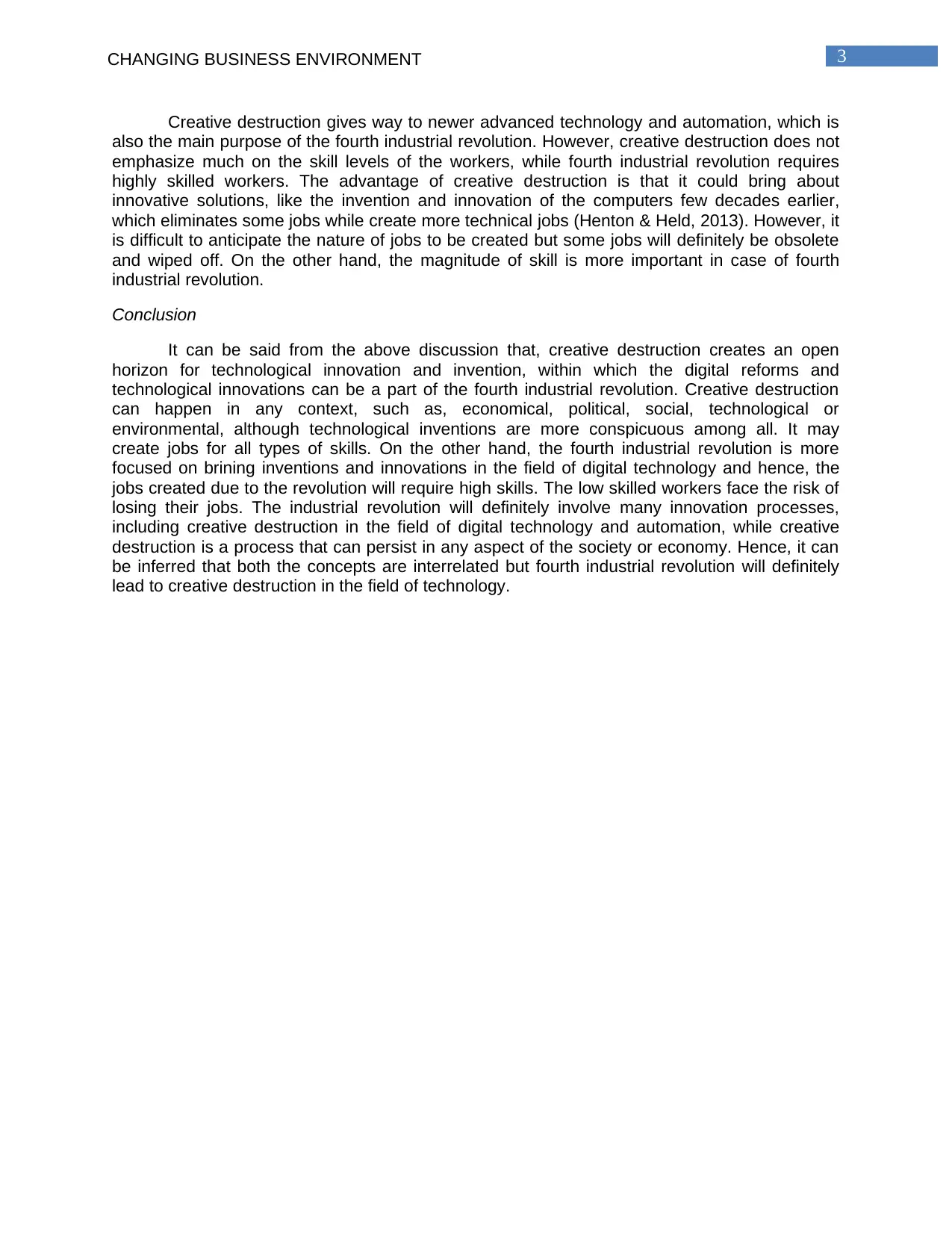
3CHANGING BUSINESS ENVIRONMENT
Creative destruction gives way to newer advanced technology and automation, which is
also the main purpose of the fourth industrial revolution. However, creative destruction does not
emphasize much on the skill levels of the workers, while fourth industrial revolution requires
highly skilled workers. The advantage of creative destruction is that it could bring about
innovative solutions, like the invention and innovation of the computers few decades earlier,
which eliminates some jobs while create more technical jobs (Henton & Held, 2013). However, it
is difficult to anticipate the nature of jobs to be created but some jobs will definitely be obsolete
and wiped off. On the other hand, the magnitude of skill is more important in case of fourth
industrial revolution.
Conclusion
It can be said from the above discussion that, creative destruction creates an open
horizon for technological innovation and invention, within which the digital reforms and
technological innovations can be a part of the fourth industrial revolution. Creative destruction
can happen in any context, such as, economical, political, social, technological or
environmental, although technological inventions are more conspicuous among all. It may
create jobs for all types of skills. On the other hand, the fourth industrial revolution is more
focused on brining inventions and innovations in the field of digital technology and hence, the
jobs created due to the revolution will require high skills. The low skilled workers face the risk of
losing their jobs. The industrial revolution will definitely involve many innovation processes,
including creative destruction in the field of digital technology and automation, while creative
destruction is a process that can persist in any aspect of the society or economy. Hence, it can
be inferred that both the concepts are interrelated but fourth industrial revolution will definitely
lead to creative destruction in the field of technology.
Creative destruction gives way to newer advanced technology and automation, which is
also the main purpose of the fourth industrial revolution. However, creative destruction does not
emphasize much on the skill levels of the workers, while fourth industrial revolution requires
highly skilled workers. The advantage of creative destruction is that it could bring about
innovative solutions, like the invention and innovation of the computers few decades earlier,
which eliminates some jobs while create more technical jobs (Henton & Held, 2013). However, it
is difficult to anticipate the nature of jobs to be created but some jobs will definitely be obsolete
and wiped off. On the other hand, the magnitude of skill is more important in case of fourth
industrial revolution.
Conclusion
It can be said from the above discussion that, creative destruction creates an open
horizon for technological innovation and invention, within which the digital reforms and
technological innovations can be a part of the fourth industrial revolution. Creative destruction
can happen in any context, such as, economical, political, social, technological or
environmental, although technological inventions are more conspicuous among all. It may
create jobs for all types of skills. On the other hand, the fourth industrial revolution is more
focused on brining inventions and innovations in the field of digital technology and hence, the
jobs created due to the revolution will require high skills. The low skilled workers face the risk of
losing their jobs. The industrial revolution will definitely involve many innovation processes,
including creative destruction in the field of digital technology and automation, while creative
destruction is a process that can persist in any aspect of the society or economy. Hence, it can
be inferred that both the concepts are interrelated but fourth industrial revolution will definitely
lead to creative destruction in the field of technology.
Secure Best Marks with AI Grader
Need help grading? Try our AI Grader for instant feedback on your assignments.
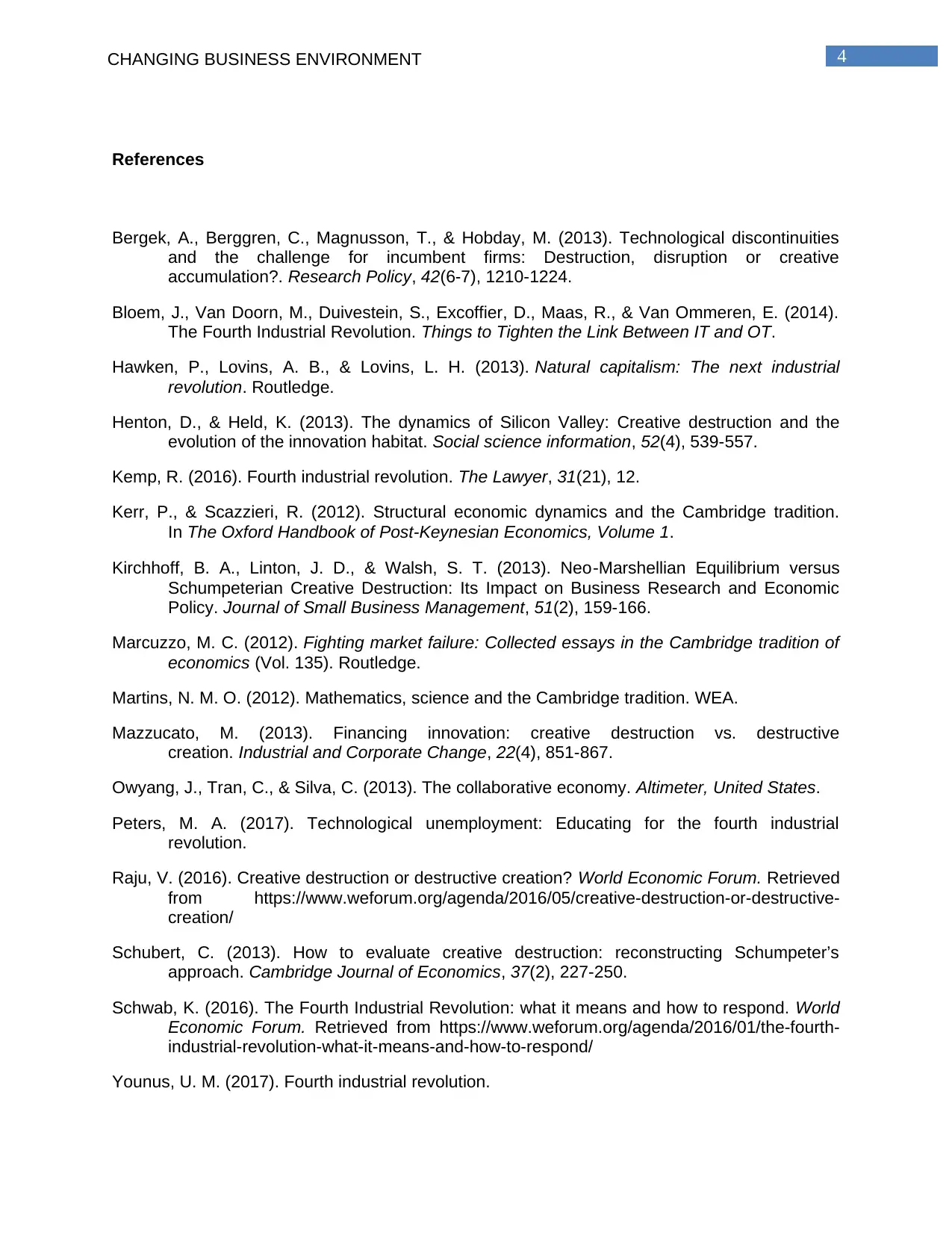
4CHANGING BUSINESS ENVIRONMENT
References
Bergek, A., Berggren, C., Magnusson, T., & Hobday, M. (2013). Technological discontinuities
and the challenge for incumbent firms: Destruction, disruption or creative
accumulation?. Research Policy, 42(6-7), 1210-1224.
Bloem, J., Van Doorn, M., Duivestein, S., Excoffier, D., Maas, R., & Van Ommeren, E. (2014).
The Fourth Industrial Revolution. Things to Tighten the Link Between IT and OT.
Hawken, P., Lovins, A. B., & Lovins, L. H. (2013). Natural capitalism: The next industrial
revolution. Routledge.
Henton, D., & Held, K. (2013). The dynamics of Silicon Valley: Creative destruction and the
evolution of the innovation habitat. Social science information, 52(4), 539-557.
Kemp, R. (2016). Fourth industrial revolution. The Lawyer, 31(21), 12.
Kerr, P., & Scazzieri, R. (2012). Structural economic dynamics and the Cambridge tradition.
In The Oxford Handbook of Post-Keynesian Economics, Volume 1.
Kirchhoff, B. A., Linton, J. D., & Walsh, S. T. (2013). Neo‐Marshellian Equilibrium versus
Schumpeterian Creative Destruction: Its Impact on Business Research and Economic
Policy. Journal of Small Business Management, 51(2), 159-166.
Marcuzzo, M. C. (2012). Fighting market failure: Collected essays in the Cambridge tradition of
economics (Vol. 135). Routledge.
Martins, N. M. O. (2012). Mathematics, science and the Cambridge tradition. WEA.
Mazzucato, M. (2013). Financing innovation: creative destruction vs. destructive
creation. Industrial and Corporate Change, 22(4), 851-867.
Owyang, J., Tran, C., & Silva, C. (2013). The collaborative economy. Altimeter, United States.
Peters, M. A. (2017). Technological unemployment: Educating for the fourth industrial
revolution.
Raju, V. (2016). Creative destruction or destructive creation? World Economic Forum. Retrieved
from https://www.weforum.org/agenda/2016/05/creative-destruction-or-destructive-
creation/
Schubert, C. (2013). How to evaluate creative destruction: reconstructing Schumpeter’s
approach. Cambridge Journal of Economics, 37(2), 227-250.
Schwab, K. (2016). The Fourth Industrial Revolution: what it means and how to respond. World
Economic Forum. Retrieved from https://www.weforum.org/agenda/2016/01/the-fourth-
industrial-revolution-what-it-means-and-how-to-respond/
Younus, U. M. (2017). Fourth industrial revolution.
References
Bergek, A., Berggren, C., Magnusson, T., & Hobday, M. (2013). Technological discontinuities
and the challenge for incumbent firms: Destruction, disruption or creative
accumulation?. Research Policy, 42(6-7), 1210-1224.
Bloem, J., Van Doorn, M., Duivestein, S., Excoffier, D., Maas, R., & Van Ommeren, E. (2014).
The Fourth Industrial Revolution. Things to Tighten the Link Between IT and OT.
Hawken, P., Lovins, A. B., & Lovins, L. H. (2013). Natural capitalism: The next industrial
revolution. Routledge.
Henton, D., & Held, K. (2013). The dynamics of Silicon Valley: Creative destruction and the
evolution of the innovation habitat. Social science information, 52(4), 539-557.
Kemp, R. (2016). Fourth industrial revolution. The Lawyer, 31(21), 12.
Kerr, P., & Scazzieri, R. (2012). Structural economic dynamics and the Cambridge tradition.
In The Oxford Handbook of Post-Keynesian Economics, Volume 1.
Kirchhoff, B. A., Linton, J. D., & Walsh, S. T. (2013). Neo‐Marshellian Equilibrium versus
Schumpeterian Creative Destruction: Its Impact on Business Research and Economic
Policy. Journal of Small Business Management, 51(2), 159-166.
Marcuzzo, M. C. (2012). Fighting market failure: Collected essays in the Cambridge tradition of
economics (Vol. 135). Routledge.
Martins, N. M. O. (2012). Mathematics, science and the Cambridge tradition. WEA.
Mazzucato, M. (2013). Financing innovation: creative destruction vs. destructive
creation. Industrial and Corporate Change, 22(4), 851-867.
Owyang, J., Tran, C., & Silva, C. (2013). The collaborative economy. Altimeter, United States.
Peters, M. A. (2017). Technological unemployment: Educating for the fourth industrial
revolution.
Raju, V. (2016). Creative destruction or destructive creation? World Economic Forum. Retrieved
from https://www.weforum.org/agenda/2016/05/creative-destruction-or-destructive-
creation/
Schubert, C. (2013). How to evaluate creative destruction: reconstructing Schumpeter’s
approach. Cambridge Journal of Economics, 37(2), 227-250.
Schwab, K. (2016). The Fourth Industrial Revolution: what it means and how to respond. World
Economic Forum. Retrieved from https://www.weforum.org/agenda/2016/01/the-fourth-
industrial-revolution-what-it-means-and-how-to-respond/
Younus, U. M. (2017). Fourth industrial revolution.

5CHANGING BUSINESS ENVIRONMENT
1 out of 6
Related Documents
Your All-in-One AI-Powered Toolkit for Academic Success.
+13062052269
info@desklib.com
Available 24*7 on WhatsApp / Email
![[object Object]](/_next/static/media/star-bottom.7253800d.svg)
Unlock your academic potential
© 2024 | Zucol Services PVT LTD | All rights reserved.





